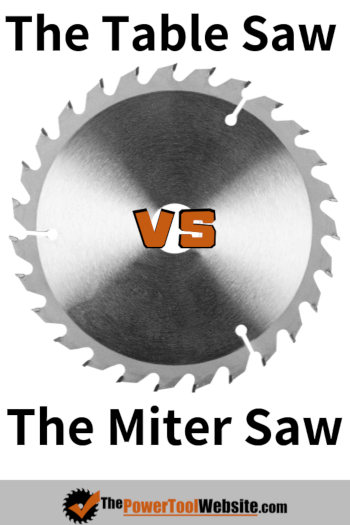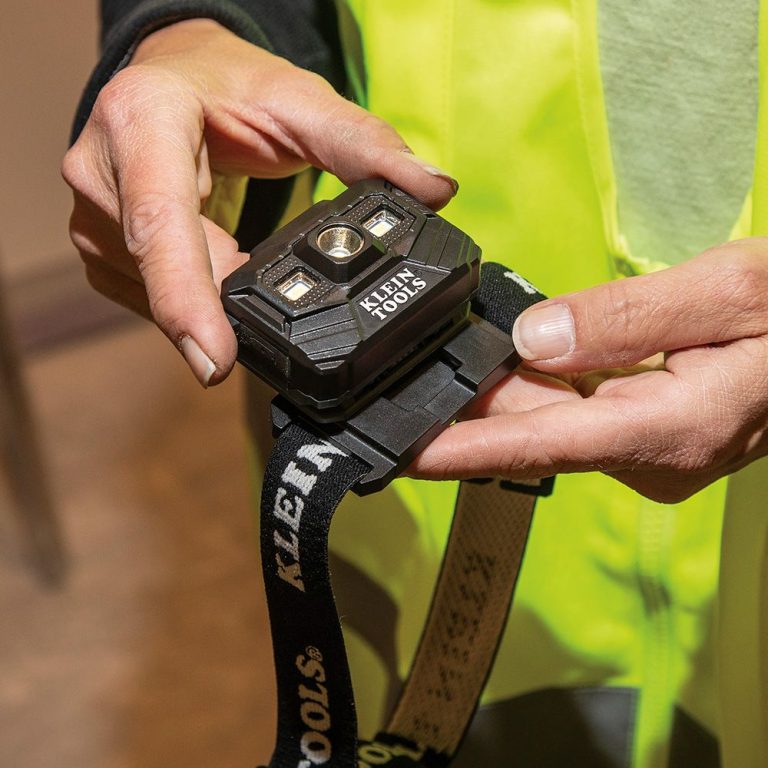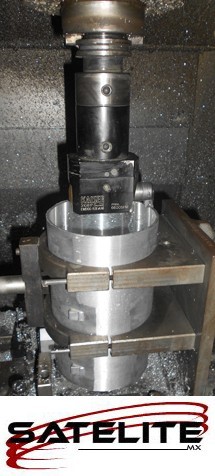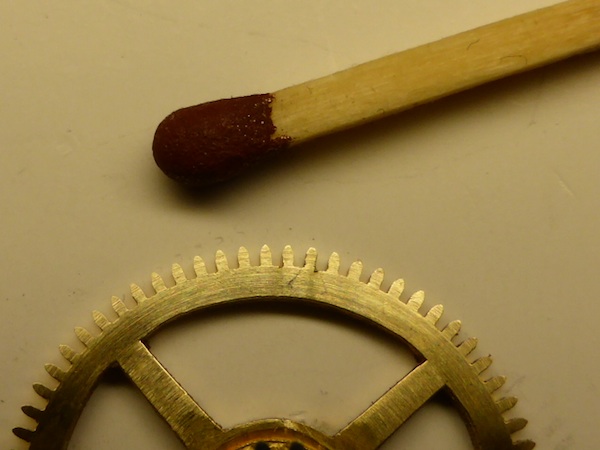Table Saw Vs Miter Saw – Find Out Which Is Best For You
So you’re at a crossroads. You want to invest some money in a good woodworking power tool that can handle all (or most) of your cuts. The choice really comes down to the table saw vs the miter saw. Your decision really depends on what types of projects you’ll be using it for.
I’ve been doing DIY home renovation projects, as well as building furniture as a woodworking hobbyist for years now, and here’s what I’ve figured out: Sometimes one just makes more sense than the other. But what’s important is this: You should be able to make accurate cuts, safely, on the projects you enjoy.


So below you’ll find the key ingredients that should go into your decision making process for choosing either a table saw, or a miter saw. You’ll learn the differences in how the two saws function, how each saw handles various common cuts, as well as how they handle specialty cuts.
You’ll also learn which of these 2 common power tools is best suited for you, depending on the types of projects you will be working on.
Quick Note: Both tools, purchased new, will come with that tools appropriate safety features, so this will not be a topic covered here.
The Main Functional Differences Between A Table Saw & A Miter Saw
The table saw has a stationary blade and you move the board through the blade to make the cut.
The miter saw’s blade (and motor) move down to make a cut into a stationary board.
So the 2 saws are fundamentally different in that regard. With one you move the board to cut, with the other you move the blade to cut.
Another difference is space. A table saw will take up more space in your shop. It also requires a certain amount of clearance at the front and back, and some on each side as well.
A miter saw can be backed up against a wall, because it doesn’t require the clearance behind the tool like a table saw. But the miter saw requires more clearance on either side of the tool.
And finally, another big obvious difference in a table saw vs a miter saw is the price. A decent miter saw will set you back a few hundred bucks, while a decent table saw ranges from $500 to over a grand.
So for some people, that’s enough said. You may know everything you need to make your decision… Or do you?
There are reasons why so many woodworkers consider the table saw the most important tool in their shop.
Continue reading to learn more about the differences and then you can determine if the added cost and space requirements of a table saw is worth it, or if the miter saw really is all you need.
Basic, Essential Cuts – How Each Tool Handles The Job
Cross Cut
This is simply cutting across the grain of a board, and it’s where a miter saw really shines. The miter saw is made for quick and easy cross cuts.
To make a cross cut on the table saw, you’ll need to use the saws miter gauge. This supports the board across the saw and keeps it secure at 90 degrees as you push it forward through the cut.
Another common way to cross cut on a table saw is using a cross cut sled (I’ll also link to it below).
Rip Cut
This is the table saws specialty. Right out of the box it’s designed to easily and accurately handle rip cuts, which is when you cut the length of the board, typically with the grain.
This is a critical cut for woodworking projects, and unfortunately, the miter saw can’t make this type of cut.
If all you have is a miter saw, then you will need to avoid projects which require ripping a board down to a narrower width than it is right from the lumber yard. That also means you’ll need to purchase lumber that is jointed on both ends. So not only is it more difficult to plan your projects, but the boards you buy will be more expensive.
On the flip side, if all you want to do is work with dimensional pine lumber for easy, rustic style projects, then rip cutting may not be 100% necessary.
Miter Cut
This is another way of saying angled cut, where the blade is rotated side to side. Its most common type is a 45 degree cut made for producing mitered corners, which is common for trim molding and picture frames.
The miter saw can easily handle miter cuts by adjusting the miter angle of the blade to the desired angle in degrees.
The table saw handles the miter cut by using the miter gauge and adjusting it to the angle you need. It works just as well, but it’s not quite as quick and simple to set up as the miter saw.
But you can also build table saw sleds like a dedicated 45 degree sled, which pushes the table saw up in rank, making it the easiest and most accurate miter cutting tool. (I’ll also link to that article below).
Bevel Cut
This is a cut made by tilting the blade to an angle other than 90 degrees from the table. This is most commonly used for trim molding, but can also be used for specialty cuts like raised panel doors (when coupled with the right sled on your table saw).
The miter saw is made for this cut, assuming you’re cutting things like trim molding and base boards.
The table saw has a bevel adjustment that tilts the blade, and the tilted blade can be used for cross cuts with your miter gauge, or rip cuts with your rip fence. So the benefit here is that you can do your molding and casing work, but you can also make bevel cuts along the length of the board. This is something the miter saw cannot handle.
Compound Cut
This is when you cut a miter and a bevel at the same time, and is mostly used for things like crown molding.
The miter and bevel features of both the miter saw and the table saw will handle your compound cutting needs, but the miter saw makes it easier.
Specialty Cuts – Why The Table Saw Reigns Supreme
There’s always a technique for accomplishing a cut using your table saw, and the same just can’t be said for a miter saw.
Given the right table saw technique, and in some cases the right sled or jig, you can make the following cuts on your table saw:
- Rabbets
- Grooves
- Dados
- Notches
- Box joints
- Dovetails
- Tenons
- Splines
- Tongues
- Thin-rip cuts
- Edge jointing
- Tapers
These cuts will be entirely handled on your table saw. (The only exception may be rabbets and dados, which can be done across the grain up to a certain width, if using the right kind of sliding miter saw.) And while this list is not all-inclusive, it really shows how versatile the table saw is.
But I can promise you one thing. If you intend on becoming a well-rounded woodworker, the table saw will become the heart of your wood shop. And the more you learn about sleds and jigs, and the more projects you build, the more you’ll love your table saw.
Table Saw Vs Miter Saw – It Really Comes Down To This
Ultimately, it comes down to the types of projects you personally want to build. Here’s a few cases when a miter saw is all you would need in your shop:
- If you’re just doing construction projects, cutting mainly dimensional 2x4s, 2x6s, 4x4s, and decking, go with a miter saw.
- If you’re a contractor on a job site, or homeowner doing DIY projects, and you intend on cutting a lot of base board, window casings, door frames, and crown molding, go with a miter saw.
- If you’re a beginner woodworker and all the projects will use basic dimensional lumber, and no specialty joinery or cuts are required, go with a miter saw.
If you do NOT fall into one of the 3 categories above, you’ll probably be better off getting a decent table saw. It will allow you to not only take on construction, renovation, and beginner woodworking projects, but also will allow you to grow your skills and capabilities. You will be equipped to become a highly capable, well-rounded woodworker, even in a small shop.
And if there’s one thing I’ve learned in my years of woodworking, it’s that this hobby is one that truly builds your desire and passion over time. The more projects you build, the more you will love what you’re doing, and the more advanced you will want to become.
Table Saw vs Miter Saw – Tool Features To Consider When Buying
When table saw shopping, you’ll be deciding between portable jobsite grade saws, hybrid saws, and full cabinet saws. With each type, the price (and the weight and size) go up, respectively.
>>> Read all about how to choose a table saw here
The cheaper saws are more mobile and may or may not support a dado blade set. In case you don’t know, the dado blade is a groove-cutting set that stacks on the arbor of the motor. The bigger the saws motor, the more weight it can support, the more dado stacking it will support.
Also, the cheaper table saws will usually have an aluminum table. This reduces weight, but is generally seen as a sacrifice. By that I mean it’s a downgrade from what you’ll get in a hybrid or cabinet saw…
The bigger table saws (hybrids and cabinet saws) will likely have cast iron tables. These are very heavy, and incredibly flat and stable. These saws are not designed to be moved around, at least not easily. They typically have more power, and some of them will require 240 volts, which means a special electrical circuit must be installed, as well as a special wall outlet.
The miter saw on the other hand will have available features like “Sliding” and “Laser Guide” and “Work Light”. The “Sliding” miter saws are a big upgrade from standard miter saws, as they have much higher cross-cutting capacity.
Don’t get over-sold on the word “compound”. Any miter saw you get anymore is a compound miter saw. That just means it can bevel and miter at the same time, producing “compound” cuts.
And while many miter saws are labeled “single bevel compound”, meaning they only bevel cut to one side, there are dual-bevel miter saws available too. This is important if you plan on doing a lot of compound miter cuts.
The most well-rounded miter saws will use a 10” blade, and can cut at least the depth of 3-½”, that way you can cut a dimensional 4×4 post. It’s also helpful to choose a sliding variation of the saw.
That wraps up the table saw vs miter saw comparison. You should now be able to confidently decide which power tool is worth spending some money on for your wood shop.
Be sure to sign up below and I’ll send projects and woodworking tips right to your inbox.
Related:
Table Saw 101 – Understand Your Tool
Table Saw Sled
Dedicated 45 Degree Miter Sled
Choosing a Miter Saw
9 Wood Shop Projects To Get You Started





